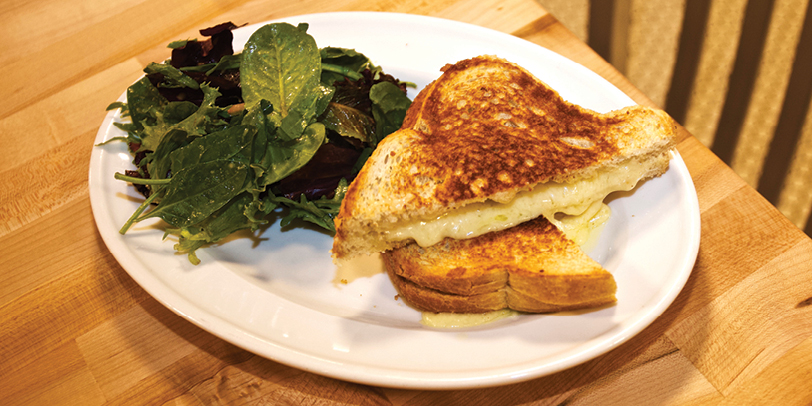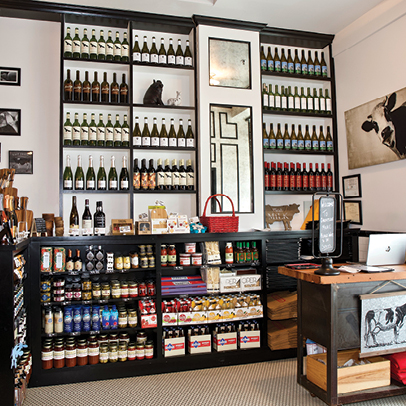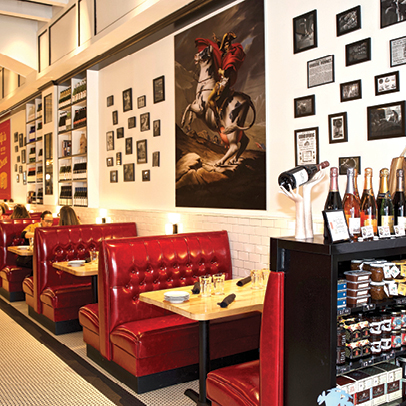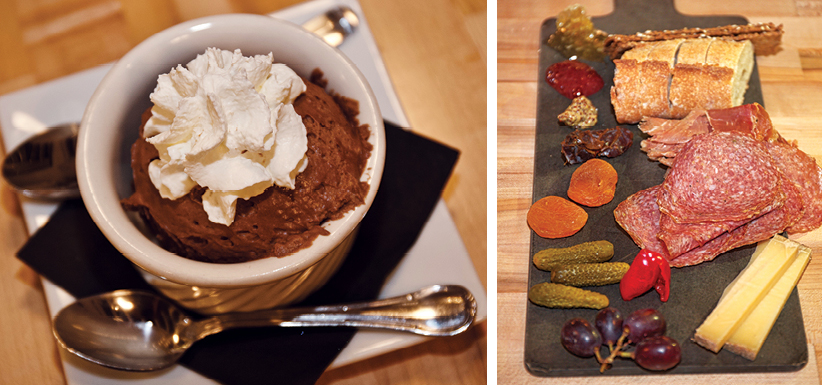“Every cheese tells a story,” says Andrew Corbley, Head Cheese Monger at Cheesetique in the Mosaic District.
I’m asking about a cheese I see in the bright Cheesetique refrigerator case. Corbley describes Morbier, a creamy cow’s milk cheese from France with a mysterious black line in the middle, “Morbier is separated with a line of ash made from leftover grape solids. They put this ash over a layer of morning milk and add a layer of ash. Then, they layer the evening milk on top.”
As head cheese buyer for the Mosaic District’s Cheesetique restaurant and shop, Corbley relishes helping his customers learn about and purchase cheeses to take home or sample on Cheesetique’s cheeseboards. Just 25 years old, Corbley passionately studies every aspect of cheese making—from its terroir, to its heritage, flavor, consistency and aroma. “Wine grapes can exist in a few environments, whereas cheese can exist in any environment. So, the number of compounding factors in how you can make a cheese taste is kind of ludicrous. Every cheese is a tool for me to travel the world.”
Cheesetique is the brainchild of entrepreneur owner Jill Erber. In 2004, she opened her first location in Alexandria’s Del Ray neighborhood. “At first, Jill sold cheese alone in her shop,” explains Corbley. “She felt cheese and wine were European traditions, but she wanted to make them easily accessible and available to people in a way they can learn.”



That cheese shop expanded into a small empire with four busy locations—Del Ray, Shirlington, Ballston and the Mosaic District in Fairfax—and each has three distinct sections. There’s a gourmet grocery section with wines and condiments, showcasing products like Savannah Bee Honeycomb and Divina Fig & Cocoa Spread. The cheese shop features curated cheeses, including goat, sheep and cow’s milk cheeses. The restaurant section is an ideal place to sample those cheeses on a colorful cheeseboard that includes flatbread crackers and baguette slices, strawberry jam, peppadew peppers, apricots, grapes and cornichons.
Currently, Erber produces a weekly blog where she muses on a variety of subjects—like how to make the perfect grilled cheese sandwich; how to put together a cheeseboard at home; and techniques for pairing cheese with wine and meat. “Jill’s blog is called Cheeseboard Weekly. She also posts a weekly story on Instagram called Friday Night Cheese,” mentions Cheesetique assistant manager Cannaith Thomas.
Diners can also enjoy wine tasting with Cheesetique’s flights of wine—reds, whites, and during the holidays, bubbly. The experience is festive, yet Cheesetique retains a neighborhood feel where people gather together to relax and chat. On Tuesdays, diners come to play the restaurant’s Pour House Trivia game while indulging in Cheesetique’s cheese-oriented menu.
I stopped in for the lunch special which includes any grilled cheese sandwich, a bowl of tomato soup and mixed greens for $10. I ordered The Grown-Up featuring artisan Prairie Breeze Cheddar on grilled sourdough bread. It was exactly how I imagine the perfect grilled cheese sandwich should be. My server told me the Pimiento Grilled Cheese Sandwich, concocted with Dragon’s Breath, Dubliner, Adam’s Reserve Cheddar and pimiento peppers is another top seller and I should try that one next time.
Cheesetique may be best known for Mac N’Cheesetique, a combination of Goat Gouda, Asiago and Cacio de Roma cheeses topped with truffle-infused bread crumbs. This recipe was named Travel & Leisure’s Best Mac n’ Cheese in America in 2013 and is featured in Food Network’s Thanksgiving Side Dish slideshow. For those seeking a lighter meal, consider the Arugula & Warm Goat Cheese Salad or Farro Medley, but save room for Cheesetique’s extraordinary Chocolate Mousse; it’s smooth and creamy with the flavor of dark chocolate.
When you’re looking for a friendly restaurant, with superb service and the opportunity to learn while you eat, check out Cheesetique.
How Do Sheep, Goat and Cow’s Milk Cheeses Differ?
After my lunch, I hopped up onto a bar stool to chat with Corbley. I’ve always wondered how goat, sheep and cow milk cheeses differ, besides the animals from which they come. Corbley was thrilled to discuss the subject. Here is his explanation:
Cow’s Milk Cheeses Like Cheddar and Brie
Corbley: Cow, Sheep and Goat Milk Cheeses are different in flavor and chemical makeup. All cheese has lactose. It’s not a complex carbohydrate. Cow’s milk is used in a lot of cheese, especially ones with additives. I have two cheeses from Britain that are filled with cranberry and another filled with dried mango and ginger. Any cheese you’re going to add stuff into is generally cow’s milk. Soft ripened cheese, like brie, is made with cow’s milk. It’s structurally sound and consistent. You know what it’s going to do, and it generally has a milder flavor.
Sheep’s Milk Cheeses Like Manchego and Pecorino Toscano
Corbley: The structure of fats and proteins are not as consistent which makes a sheep cheese less predictable, and in this case a little saltier. Sheep’s milk cheese is semi-firm, nutty and oily—for example, sheep’s milk feta is generally saltier than cow’s milk feta.
Goat’s Milk Cheeses Like Chèvre and Kefir
Corbley: Goat cheese is often described as tangy or sour. If you’ve ever had Kefir or Chèvre, you’ll notice a tangy bitterness. Goat milk is even more unstable and varied in formula than sheep. This instability affects the length of aging in cheese-making. We have 6-month goat cheese, called Midnight Moon, and it crumbles apart. It doesn’t want to stay together, because it doesn’t have much moisture.
Cheesetique In Mosaic District
2985 District Ave #115
Fairfax, VA 22031
(703) 280-1111
www.cheesetique.com







